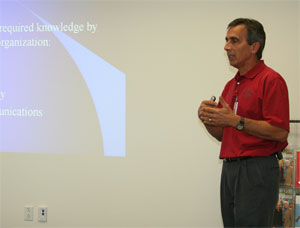Information Sharing, Technology Key to Efficient Emergency Response
By Anna Lynn Spitzer
July 28, 2006-- Public service agencies must do a better job of sharing information in order to provide effective assistance during emergencies. That was the key message delivered by Rich Toro, Orange County Fire Authority information technology and communications supervisor, in a recent Project ResCUE seminar at Calit2@UCI. Toro told the packed house that the best way to facilitate the necessary resource-sharing is by utilizing emerging technologies.
|
Toro, who has worked in Orange County, Calif.’s public safety communications arena for 31 years, told the audience that the county’s agencies – police, fire, emergency medical services and safety – have been sharing resources since 1934, making it a unique entity.
The O.C. Fire Services, which is comprised of 12 fire agencies and 1500 fire fighters, serves 32 cities and a large unincorporated area, covering nearly 1,000 square miles. It responds to approximately 250,000 incidents a year, 75 percent of which are EMS 911 calls, says Toro.
Fifteen thousand radios are linked in the shared system, which utilizes “trunking” – the keying of radios to computer controls that search for available frequencies and divide up the available lines. “Interoperability is the key to public safety,” he asserted.
Nowhere was that principle more absent than in New York City on Sept. 11, 2001. Disparate systems lacked the ability to communicate with each other, leading to chaos and confusion.
In order to prevent a repeat of those events, the U.S. Department of Homeland Security is offering grants to public agencies for purchases that can help them receive, transmit and deliver emergency services in the most expedient manner. “Situational awareness and information dissemination are essential,” Toro said. “It’s all about getting the right information to the right person at the right time during crisis response.”
Computer Aided Dispatch and mobile data systems are among the technologies that can facilitate this effort. CAD systems automate critical dispatch and call-processing functions – eliminating human error – while mobile data systems, a CAD component, receive emergency dispatch information and perform status-keeping functions.
Other technology-aided systems that can facilitate the delivery of emergency care are upgraded paging, station-alarm and voice-wireless systems, as well as Geographic Information System mapping capabilities.
VoIP voice and data networks, private wireless capability for mission-critical applications and ad-hoc mesh networks that utilize multiple network technologies are additional approaches to expediently delivering emergency care.
Toro envisions a mutually beneficial relationship between OCFA and the NSF-funded ResCUE project underway at UCI. “Everyone benefits from sharing resources,” he says. “UCI is in the forefront of research and development, while OCFA has the test bed for the applications, but is not funded for R&D.” He advocates internship programs, joint participation in projects and programs, and collaboration on drills and events.
“We’re trying to improve incident response times and officer safety, increase situation awareness for first responders and establish interoperability for information sharing, leading to improved service efficiency,” he concludes.
Related Projects
Responding to Crises and Unexpected Events
ResponSphere


